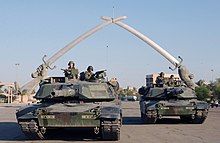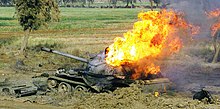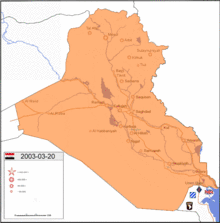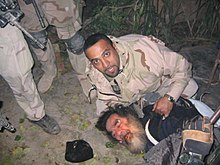Iraq War
![]()
This article is about the war waged by a coalition of states led by the United States against Iraq in the spring of 2003. For earlier wars with Iraq, see First and Second Gulf Wars. For the subsequent period, see Occupation of Iraq 2003-2011.
Iraq War

Clockwise from top left: a patrol in Samarra; a statue of Saddam is torn down; an Iraqi soldier in combat; a bomb explodes near a U.S. convoy in southern Baghdad.
The Iraq War or Third Gulf War (also Second Iraq War) was a military operation in Iraq by the United States, the United Kingdom and a "coalition of the willing". It began on 20 March 2003 with the bombing of selected targets in Baghdad, leading to the capture of the capital and the overthrow of the then Iraqi dictator Saddam Hussein. On 1 May 2003, US President George W. Bush declared the war victoriously over.
Bush's US administration had been considering the overthrow of Saddam Hussein since January 2001. It justified this as a necessary preventive war to prevent an allegedly imminent attack by Iraq on the USA with weapons of mass destruction. The USA and Great Britain interpreted UN Resolution 1441 as a UN mandate for military intervention. In it, the UN Security Council had condemned Iraq for, among other things, failing to meet its obligation to eliminate and control its weapons of mass destruction, supporting terrorism, and repressing its population, and authorized all UN member states to use "all necessary means" to enforce compliance with UN resolutions. However, the US and UK did not receive an explicit mandate from the Security Council to attack militarily. Many lawyers therefore consider the Iraq war to be a breach of the UN Charter's prohibition of a war of aggression and therefore illegal under international law. However, the USA and Great Britain prevented the UN Security Council from condemning the Iraq war with their veto. Since no weapons of mass destruction were found in Iraq, apart from old remnants, and no evidence of acute intent to attack, the justification put forward for the Iraq war has been shown to be false.
After the declared end of the war, civil war-like conditions, thousands of terrorist attacks, acts of war and violent crime, both by different Iraqi groups against each other and against the Western occupation forces, occurred during the occupation of Iraq in 2003-2011. They caused an unknown number of deaths and injuries, especially among Iraqi civilians. Even after the withdrawal of foreign troops in 2011, there was no pacification of the country. The expansion of the Islamic State in the 2014 Iraq crisis is judged in part to be a consequence of the Iraq war.
History
Bombing and ground offensive
On March 17, 2003, U.S. President Bush issued an ultimatum to Saddam Hussein to leave Iraq within 48 hours or Iraq would be attacked. In response to Hussein's refusal, the war coalition opened the war, known as Operation Iraqi Freedom, with targeted bombings in Baghdad on the night of March 19-20. The U.S. fired 40 cruise missiles at the government quarter in Baghdad and suspected locations of Saddam Hussein. This so-called Shock and Awe campaign was intended to destroy Iraq's communications infrastructure and demoralize Iraqi troops.
The invasion of Western ground forces began on the same day from Kuwait and Jordan. They penetrated some 200 km inland in the first two days, and by March 24 they were some 95 km from Baghdad. This was also attributed to the Iraqi army's strictly centralized command structure, which manifested itself in rigid command tactics and an unnecessary burden on senior officers, who even had to sign off on tactical decisions. It crippled Iraqi forces against the US Army's subsidiary order tactics and modular force structure.
During the following days the war took place in five main theatres:
- British forces concentrated in southern Iraq on capturing the port city of Umm Kasr, securing oil wells in the south of the country, and encircling and then capturing the city of Basra.
- U.S. Army Special Forces took over securing H-3 and H-2 airfields in western Iraq.
- The 3rd U.S. Infantry Division advanced from the south along the Euphrates River toward Baghdad. The 1st U.S. Marine Division advanced along the Tigris River.
- In the north of Iraq, Iraqi positions on the border with the autonomous Kurdish regions apparently came under massive aerial fire. There, the Iraqi troops increasingly retreated. Kurdish troops, supported by American special forces and some airborne troops, moved into the vacated spaces: On March 26, one thousand paratroopers from the 173rd U.S. Airborne Brigade landed in the Kurdish areas to the north to open a northern front.
- The de facto air superiority of the Americans since the end of the Second Gulf War was used to fly permanent attacks on tactical or strategic targets in cities as well as to support the ground forces.
The fiercest resistance was encountered by those troops who were advancing towards Baghdad. After about ten days, this advance came to a standstill. There were several reasons for this: a very violent sandstorm that severely compromised weapons systems such as helicopters, resistance from Iraqi troops trying to protect critical passages across the Euphrates, and the rapid initial advance that left a long supply line relatively unsecured. American troops launched initial attacks on the Republican Guard on March 30. CENTCOM claims to have maintained pressure on the Iraqi military for the duration of the sandstorm by increasing aerial bombardment.
But then Iraqi resistance (not militia resistance) quickly collapsed. Basra was besieged by British troops for about a week. On April 7, the British entered this second largest city in Iraq. There was no significant resistance, but there were casualties on the Iraqi side. According to speculation in the French newspaper Le Journal de Dimanche and the Egyptian newspaper al Usbu, a close confidant of Saddam Hussein, General Mahere Sufian al-Tikriti, was bribed with 25 million US dollars by the CIA and subsequently withdrew the troops of the Republican Guard.
Battle of Baghdad
→ Main article: Battle for Baghdad (2003)
The Iraqi capital was reached by US ground forces on about April 5. The city's airport was captured on April 4. On April 7, American troops advanced into the city center for the first time. There was no house-to-house fighting, as had been feared, but there were heavy casualties on the Iraqi side. The American forces brought the city within the next four days to a large extent under their control, nevertheless it still came to small fights. The city of Kirkuk also fell to Kurdish fighters on April 11. Later, U.S. Army officials gave a reason for the low resistance (the long-distance roads through the desert had remained completely intact, there were no mines and virtually no resistance around Baghdad): Some officers had been bribed in advance of the fighting. On April 14, the Pentagon declared the war over, as the last contested city of Tikrit was taken. Saddam Hussein remained untraceable at this time.
During the symmetrical combat operations, the United States operated with several relatively new strategies. Based on their assumption that the entire Iraqi state depended on its ruler, Saddam Hussein, they targeted him with the decapitation strike strategy. The success of this strategy, which did not materialize due to a lack of accuracy or unclear information about Hussein's whereabouts, together with the targeting of other subordinate nodes of the strictly hierarchical warfare, was to lead to the psychological and de facto paralysis of the enemy forces. The armed forces of the USA themselves had tried to protect themselves against a possible similar warfare of the opponent with various defence policy measures in addition to an armament that had been pushed for years. As a result of the strategy papers Joint Vision 2010 and Joint Vision 2020, they had developed network-centric warfare, by which the political and military leadership was limited to prescribing the objectives and providing the necessary means, while the execution was to be reserved for the tactical and operational batches.
Iraq's armed forces confined themselves to a predominantly passive approach with many defensive constructions such as trenches and paramilitary bonds.
Occupation and arrest of Hussein
→ Main article: Occupation of Iraq 2003-2011
The war was followed by the occupation of Iraq by the Coalition of the Willing, which lasted from 2003 to 2011. On 22 May 2003, the UN Security Council adopted Resolution 1483 on this, which regulated the role of the UN and the occupying powers after the war. It did note the political authority of the Coalition Provisional Authority, coupled with a reference to respecting the rules of international law. However, although the preamble to the resolution called for a supporting role for the UN, in the resolution section the two veto powers only agreed to the establishment of a UN special envoy to support reconstruction.
On 13 December 2003, Saddam Hussein was captured by US occupation forces 15 kilometres from his hometown of Tikrit. He surrendered without a fight and was later sentenced todeath by a military court for war crimes and crimes against humanity on 5 November 2006 and hanged on 30 December 2006.
Subsequently, a new democratic form of government was established in Iraq, now known as the Republic of Iraq. On 30 January 2005, Iraq held its first free elections. On 16 March 2005, the National Assembly had its first session.
On 29 June 2009, US troops left Baghdad and also withdrew from the other parts of Iraq by 2012.

M1A1 Abrams main battle tank in front of the triumphal arch Hands of Victory

Burning Iraqi T-55 near An Nu'maniyah
_launches_from_the_guided_missile_cruiser_USS_Cape_St._George_(CG_71).jpg)
A cruise missile is fired at Iraqi positions from a US cruiser in the Mediterranean Sea

Military Progress of the Iraq War. The majority of coalition forces approached from the south. Due to Turkish refusal, the US had to open the second front by air landing in the west.

Arrest of Saddam Hussein

A car bomb attack in southern Iraq

Discovery of a buried Iraqi Mig-25 fighter aircraft in al-Taqqadum in August 2003.
Media
The media around the world reported both the officially stated and suspected reasons for the war and the course of the war.
In the USA itself, the reasons for the war published by the government were largely adopted by the American mass media and hardly any other justifications were published. The New York Times wrote on 18 July 2004 that the entire American press had not been sceptical enough about the US government's justifications for the war.
Musicians who were critical of the war were no longer played by some American radio stations. For example, the Dixie Chicks, whose singer Natalie Maines said she was "ashamed" to be from the same state (Texas) as Bush.
The US-American mass media succeeded in making Iraq appear as a threat to the US-American people and in creating a climate of fear (mass hysteria) in the US-American population by constantly repeating demonstrably false claims, so that finally an overwhelming majority of the US-citizens supported a war of aggression against Iraq.
The news agency Al-Jazeera had shown pictures of dead Iraqi civilians and captured American soldiers. The channel's correspondent on the New York Stock Exchange ("Wallstreet") was excluded from the exchange with the argument that they had no resources. During the war, the station tried to set up an English-language website, which was hardly accessible during the war due to hacker attacks and technical problems.
During the Afghan war, the station's office in Kabul was hit by a US precision missile. During the Iraq war, a hotel in Basra where Al-Jazeera's staff was located was shelled by an Allied artillery position; four shells hit the hotel. When Baghdad was captured, the Al-Jazirah office was shelled by US forces. A correspondent died, a cameraman was wounded.
Also during the capture of Baghdad, the Palestine Hotel was fired upon by a tank. Many foreign journalists were staying at the hotel. Two people were killed and several were injured. U.S. General Buford Blount said the tank was fired on from the hotel. Several reporters present, however, reported that there had been no shots fired at the tank from the hotel.
The use of so-called embedded journalists (they were "involved" with fighting troops of the USA and Great Britain) was particularly criticized. Among other things, it was feared that journalists could be presented with distorted (e.g. embellished) excerpts of reality.
Search within the encyclopedia